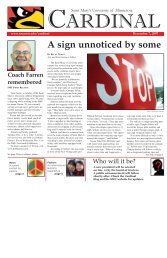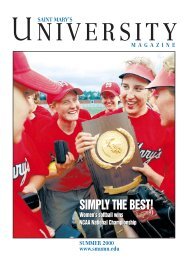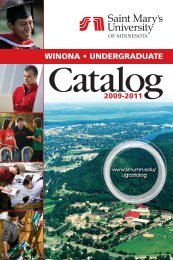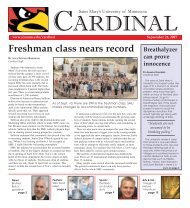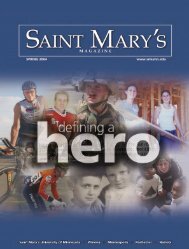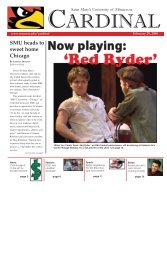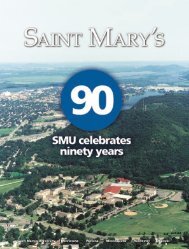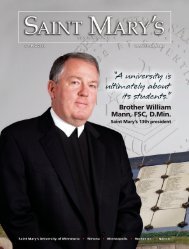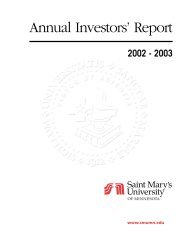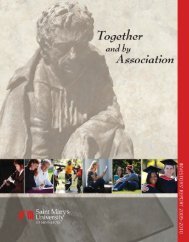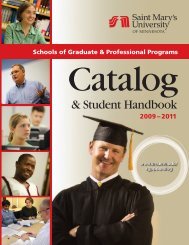Saint Mary's Magazine Fall 2004 - Saint Mary's University of Minnesota
Saint Mary's Magazine Fall 2004 - Saint Mary's University of Minnesota
Saint Mary's Magazine Fall 2004 - Saint Mary's University of Minnesota
You also want an ePaper? Increase the reach of your titles
YUMPU automatically turns print PDFs into web optimized ePapers that Google loves.
SMU ON THE WWW<br />
Beyond HTML: Enriching the<br />
Web with alternative formats<br />
In the beginning … back in the<br />
early 1990s … was the<br />
WorldWideWeb (no spaces in the<br />
name then) and the only format<br />
available was<br />
text with<br />
hyperlinks.<br />
Today, the Web<br />
is filled with a<br />
variety <strong>of</strong><br />
delivery options<br />
that can<br />
sometimes be<br />
confusing. Let’s<br />
take a look at<br />
how several <strong>of</strong><br />
these formats<br />
are used here at SMU and why<br />
they are important to you.<br />
A. Eric Heukeshoven<br />
website manager<br />
Adobe Acrobat or<br />
Portable Document<br />
Format (aka PDF)<br />
Without a doubt, Adobe PDF files<br />
are the closest thing we have to<br />
fulfilling the vision <strong>of</strong> a “paperless<br />
<strong>of</strong>fice.” A PDF document can be<br />
shared with the vast majority <strong>of</strong><br />
computers today regardless <strong>of</strong> their<br />
operating system. And yet, we still<br />
live in a world that requires<br />
signatures and paper records. For<br />
this reason alone, PDF files provide<br />
the bridge between electronic and<br />
printed documents. PDF files are<br />
typically small, the s<strong>of</strong>tware for<br />
viewing and printing these<br />
documents is free from Adobe<br />
Systems (www.adobe.com) and best<br />
<strong>of</strong> all, the layout <strong>of</strong> the original<br />
document is retained and cannot be<br />
altered as it might be if a word<br />
processing file was used instead.<br />
The SMU website uses Adobe<br />
PDF files in many places. Here are<br />
just a few <strong>of</strong> the places you’ll find<br />
PDFs on our site:<br />
Undergraduate Course Catalog:<br />
www.smumn.edu/sitepages/pid5.php<br />
Printable Undergraduate<br />
Admission Application:<br />
www.smumn.edu/sitepages/pid157.php<br />
Alumni <strong>Magazine</strong> (1999 to<br />
present) is also available in PDF<br />
format at: www.smumn.edu/magazine<br />
Audio/Video Formats<br />
MP3 Audio<br />
MP3 is short for Moving Picture<br />
Experts Group, Audio Layer III,<br />
and is a compression format that<br />
shrinks audio files with only a small<br />
sacrifice in sound quality. In the<br />
span <strong>of</strong> only a few years, MP3 has<br />
risen from obscurity to near<br />
ubiquitous status. From Napster<br />
(now a legal source <strong>of</strong> music<br />
downloads) to the iPod and iTunes,<br />
MP3 is the undisputed champ <strong>of</strong><br />
audio formats.<br />
The SMU website uses MP3<br />
files as a way <strong>of</strong> sharing audio to<br />
visitors around the world. Care to<br />
hear the SMU Alma Mater? Click<br />
over to http://av.smumn.edu/general/<br />
almamater.html.<br />
Several MP3 players are<br />
available at no charge; here are two<br />
suggestions:<br />
WinAmp for Windows:<br />
http://www.shoutcast.com/<br />
iTunes for Windows and<br />
Macintosh:<br />
http://www.apple.com/itunes/<br />
QuickTime and RealPlayer<br />
A recent Nielsen/NetRatings report<br />
indicates that more than 45 percent<br />
<strong>of</strong> U.S. homes use a “broadband”<br />
connection to access the Internet.<br />
As this trend continues, SMU plans<br />
to introduce more video content for<br />
alumni and friends.<br />
We currently <strong>of</strong>fer audio and<br />
video in QuickTime and RealPlayer<br />
formats. Both formats compress the<br />
audio and video to make it easier for<br />
people connecting at slower speeds.<br />
Video can downloaded as a file<br />
or “streamed” (viewed live in real<br />
time.) The SMU webcam<br />
(http://av.smumn.edu/webcam/) uses<br />
QuickTime streaming and has been<br />
serving up views <strong>of</strong> the Winona<br />
campus for more than four years!<br />
Another interesting<br />
application <strong>of</strong> video can<br />
be seen in our “Round<br />
Trip Tours” where<br />
QuickTime provides<br />
the engine to view 360-<br />
degree panoramas <strong>of</strong> the<br />
Winona campus. See for yourself at<br />
http://av.smumn.edu/tours/<br />
Flash<br />
A relative newcomer to the Web,<br />
Flash is an emerging technology<br />
<strong>of</strong>fering a great potential especially<br />
in the area <strong>of</strong> animation. While we<br />
have not yet incorporated Flash<br />
into the SMU external website, the<br />
format is getting some serious<br />
attention by our Office <strong>of</strong><br />
Instructional Technology (http://<br />
www2.smumn.edu/deptpages/~instruct<br />
Tech/) to provide tutorials for faculty,<br />
students and staff.<br />
Bold New World<br />
What will the Web look like in 10<br />
years? Judging from the incredible<br />
changes we have witnessed in just<br />
the past few years, I don’t think we<br />
can make any predictions except to<br />
say that the future <strong>of</strong> the Web with<br />
its many formats will continue to<br />
evolve and enrich our lives.≠<br />
20 SAINT MARY’S MAGAZINE FALL <strong>2004</strong>



